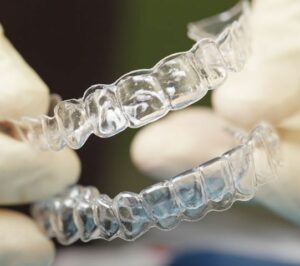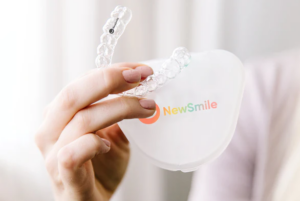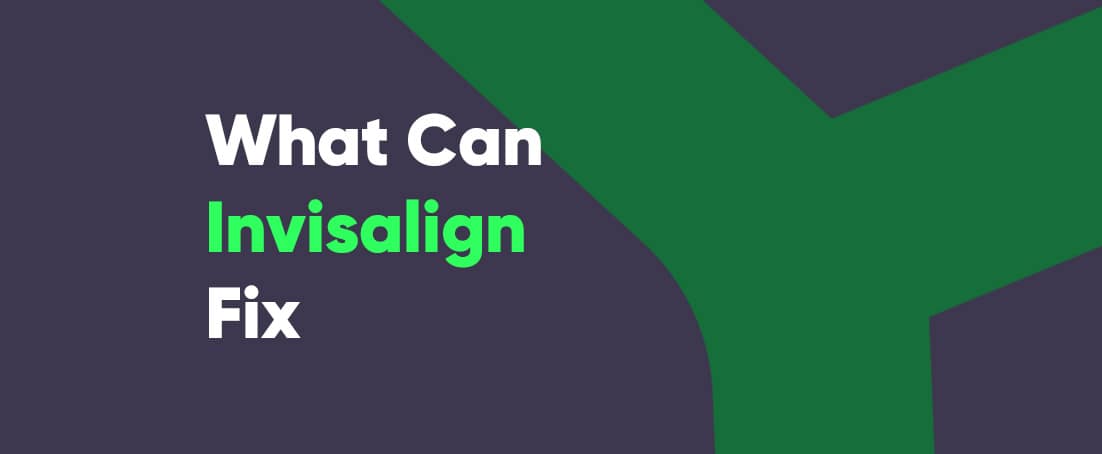Invisalign is an innovative clear aligner system that offers a discreet and comfortable alternative to traditional braces, but its capabilities extend far beyond aesthetics.
Invisalign isn’t just for minor misalignments. Several scientific studies have shown its effectiveness in treating a wide range of orthodontic issues, from mild crowding and gaps to overbites and underbites. A systematic review shows the ability of Invisalign to precisely control tooth movements allowing for adjustments in width, bite depth, and even midline discrepancies.
Stay tuned as we delve deeper into what Invisalign can fix, showcasing its impressive versatility and highlighting how it can transform your smile and oral health.
Table of Contents:
Common Dental Issues Addressed by Invisalign
Invisalign’s impressive versatility shines in its ability to address a wide range of dental concerns. Whether you have slightly overlapping teeth, gaps, or even moderate crowding, Invisalign’s clear aligners can gently guide them into their ideal positions. It can effectively correct overbites, underbites, and crossbites, improving not only your smile but also your bite function.
Unwanted gaps between teeth can be closed with Invisalign, enhancing aesthetics and making oral hygiene easier. An open bite, where the front or back teeth don’t touch when closing your mouth, can also be addressed by Invisalign.
Another common orthodontic issue that can be treated with Invisalign is midline discrepancy when the center of your upper and lower front teeth aren’t aligned. Invisalign can subtly adjust them for a more balanced smile.
Let’s view a broader picture of the potential applications of Invisalign.
Crowded Teeth
Invisalign effectively straightens crowded teeth by gently shifting them into proper alignment over time. The clear aligners are custom-made to fit snugly over your teeth, exerting gentle pressure to move them into the desired position. This gradual movement creates space within your jaw, alleviating crowding and potentially improving bite function.
When crowded teeth are straightened, they are easier to clean, reducing the risk of cavities and gum disease.
Gaps Between Teeth
Invisalign’s clear aligners are adept at closing teeth gaps, restoring symmetry to your smile. Whether it’s a midline diastema, tongue thrust, or gaps from missing teeth, or an enlarged frenulum, Invisalign clear aligners for gap teeth can effectively address various spacing issues.
The treatment duration with Invisalign varies based on gap severity, ranging from a few months for smaller gaps to up to 24 months for more severe cases. This discreet and effective solution with clear aligners offers an aesthetically pleasing alternative to traditional braces.
Overbite
Invisalign aligners effectively correct an overbite by gradually repositioning upper and lower teeth, improving bite alignment. Treatment typically lasts 12 to 24 months, varying by case.
Specifically designed elastics, attached to “buttons” on the aligners, aid in overbite correction. These elastics connect the top and bottom aligners, shifting lower teeth forward and upper teeth backward. While some cases may not require elastics, they are often essential for achieving optimal results in overbite alignment with Invisalign overbite aligners.
Underbite
If you are looking for how to fix an underbite without braces, Invisalign can be instrumental, especially in milder cases. certain types of underbites can be effectively corrected with Invisalign aligners.
The duration of Invisalign underbite treatment depends on the severity of misalignment. Particularly in adults, Invisalign is commonly utilized to address underbites caused by improper teeth positioning, offering a discreet and efficient solution.
Crossbite
Custom aligners for Invisalign are effective for treating crossbites. They gently nudge your upper teeth outward, correcting their awkward overlap with the lower ones. Each aligner applies subtle pressure, guiding the misaligned teeth into their rightful positions, millimeter by millimeter.
This precise control addresses the crossbite, improving not just aesthetics but also function and reducing potential wear and tear on your teeth.
Open Bite
Invisalign offers a potentially effective alternative to traditional braces for fixing open bite naturally. It focuses on intruding back teeth. This movement helps close the vertical gap between the upper and lower jaws, ultimately allowing the front teeth to meet properly. Correcting the open bite can lead to better tongue placement and function.
If crowding or spacing contributes to the open bite, Invisalign can simultaneously address these issues, further optimizing the bite. While Invisalign can be a valuable tool for correcting mild to moderate open bites, it’s essential to seek professional evaluation and guidance from a qualified orthodontist for a personalized treatment plan.
Crooked Teeth
Invisalign offers an effective solution for straightening crooked teeth with its customized series of clear aligners. These aligners gently exert pressure, gradually guiding teeth into proper alignment, resulting in a straighter smile.
Capable of addressing moderately severe cases, Invisalign is comparable to traditional metal braces in correcting crooked teeth. It’s a popular choice among individuals seeking to enhance both the alignment and appearance of their teeth, providing a discreet and efficient orthodontic option.
Limitations of Invisalign Treatment
While Invisalign is effective for many cases, it may not be suitable for severe orthodontic issues requiring extensive correction.
#1 Severe Malocclusions
Invisalign may not be suitable for severe cases of malocclusion due to the limitations of the clear aligners’ design, which may not provide sufficient force or control to address highly complex misalignments. Severe cases often require more precise and extensive adjustments that may be better achieved with traditional braces or other orthodontic appliances.
Furthermore, severe malocclusions may involve significant skeletal discrepancies that require orthognathic surgery, which is beyond the scope of Invisalign treatment.
#2 Tooth Rotation and Vertical Movements
Invisalign excels in horizontal tooth movements but may struggle with significant tooth rotation or vertical adjustments, particularly in canines and premolars due to their shape and position in the mouth. While it can effectively address rotations of up to 40° in central incisors and 45° in canines and premolars, severe cases exceeding these angles may require traditional braces for more aggressive treatment.
Despite improvements, Invisalign may have limitations in treating severe rotations and complex vertical movements, making traditional braces a preferable option in such scenarios.
#3 Limited Treatment for Young Children
Invisalign is typically recommended for teenagers and adults with fully developed teeth, as the aligners may not fit properly on young children whose teeth and jaws are still developing. Since Invisalign relies on precise fit and consistent wear to achieve optimal results, the shifting nature of growing teeth in young children may hinder the effectiveness of treatment.
Therefore, traditional orthodontic approaches may be more appropriate for addressing dental issues in this age group until their teeth have fully developed.
#4 Complex Skeletal Issues
Invisalign primarily focuses on addressing dental concerns and may not be suitable for significant jaw discrepancies. Cases involving complex skeletal issues often require a combination of orthodontic and surgical interventions. While Invisalign can treat overbites and underbites to some extent, severe cases may necessitate the stronger force of metal and wire braces.
Surgical intervention is typically required to correct skeletal discrepancies causing malocclusions, a treatment approach beyond the scope of Invisalign.
Benefits of Choosing Invisalign for Dental Corrections
Now that you have a thorough understanding of both the implications and limitations of Invisalign, let’s delve into some of its benefits to help you make an informed decision.
#1 Discreet Treatment
Invisalign offers a discreet treatment option with its transparent aligners, providing a nearly invisible solution for addressing dental issues. Unlike traditional braces, which are noticeable and may affect one’s appearance, Invisalign aligners are barely noticeable when worn, allowing individuals to undergo orthodontic treatment without feeling self-conscious.
This transparency makes Invisalign particularly appealing for adults and teenagers who desire a more subtle approach to straightening their teeth. With Invisalign, individuals can confidently smile and engage in daily activities without drawing attention to their orthodontic treatment.
#2 Comfortable Wear
Unlike traditional braces, Invisalign’s aligners are custom-molded to fit snugly around your teeth. This precise fit eliminates the metal brackets and wires that dig into your cheeks and tongue, causing irritation and discomfort. Plus, the smooth plastic is gentle on your gums, minimizing soreness and making wear a breeze.
With the innovative design of Invisalign, you can enjoy freedom from painful adjustments and embrace a comfortable journey towards a straighter smile.
#3 Removability
Invisalign doesn’t just straighten your teeth, it liberates you from the restrictions of traditional braces. You can easily take out your aligners effortlessly for every meal, enjoying your favorite foods without limitations. Brushing and flossing become hassle-free, ensuring optimal oral hygiene.
If you are feeling self-conscious for a big event, simply remove your aligners for temporary freedom, then wear them back later with ease. This removability empowers you to embrace life without compromise.
#4 Predictable Results
Advanced technology of Invisalign lets orthodontists precisely map your treatment journey, virtually predicting every shift and rotation. This predictability translates to controlled tooth movements, minimizing surprises and ensuring you see clear progress with each aligner change. Unlike traditional braces, adjustments are minimal, reducing discomfort and fine-tuning your smile with utmost precision.
#5 Reduced Office Visits
Invisalign streamlines your orthodontic journey by potentially reducing in-person visits compared to traditional braces. You typically wear each aligner set for 1-2 weeks before switching to the next, eliminating the need for frequent adjustments.
Some orthodontists offer progress monitoring through apps or telehealth, further minimizing physical appointments.
Remember, the exact number of visits depends on your case and your orthodontist’s plan. However, fewer trips to the office can mean more time for you and potentially lower treatment costs.
Affordable Invisalign Alternatives
Affordable Invisalign alternatives offer an attractive option for individuals seeking effective orthodontic treatment without breaking the bank. These alternatives provide similar benefits to Invisalign at a fraction of the cost, making them a worthwhile consideration for budget-conscious consumers.

The most efficient at-home teeth straightening solution you can get in the US.
- Short treatment time
- High-quality materials
- HyperByte technology
- Flexible financing options

Your best bet to save money while receiving high-quality aligners.
- Affordable pricing
- Great payment options
- Comfortable
- Effective for various dental conditions

Top-notch remote orthodontic service optimized for avoiding lengthy in-office visits.
- Best remote experience
- Great for mild-to-moderate misalignments
- Fits different gum lines well
- Board-certified dentists and orthodontists
Byte offers a convenient and efficient solution for teeth straightening with its innovative HyperByte technology. This system utilizes gentle vibrations to accelerate tooth movement, reducing treatment time and enhancing overall comfort for users. If you are wondering how does Byte work, explore our in-depth review of Byte aligners.
Candid dental aligners provide a customized and discreet treatment option, allowing individuals to achieve their desired smile without the need for frequent office visits. With remote monitoring by orthodontic professionals, Candid ensures personalized care throughout the treatment process.
AlignerCo offers an affordable and accessible option for teeth straightening with its transparent aligners. With a straightforward process and competitive pricing, AlignerCo delivers effective results while accommodating various budgetary constraints. Explore a broader picture in our AlignerCo review.
Conclusion
Invisalign stands out as a versatile and effective solution for addressing a variety of dental issues, offering benefits such as discreetness, comfort, and convenience. While alternative options exist, Invisalign’s track record of success and widespread popularity make it a top choice for many individuals seeking orthodontic treatment.
It’s essential to consult with a dental professional to assess individual needs and determine if Invisalign is the right fit. With proper guidance and care, Invisalign can help achieve a healthier, more confident smile.

